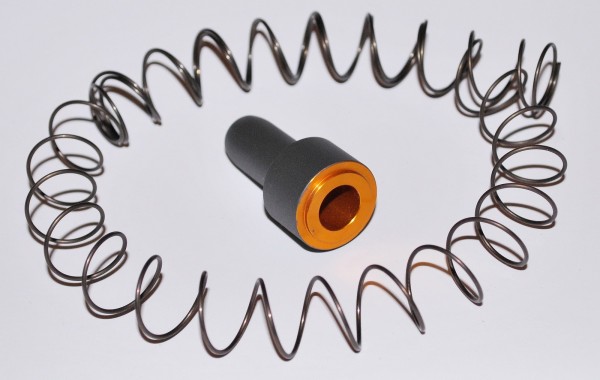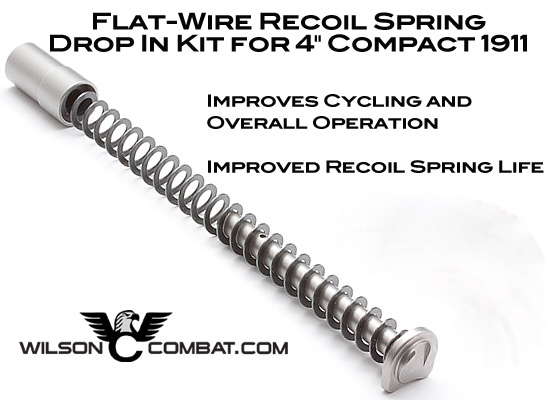
Simple to find, easy to replace yet so often overlooked, magazine springs for shotguns are very often the cause of feeding issues in shotguns.
Operating on the assumption that modern shooters who care for their equipment keep track of their round counts, most of us track the lifespan of our wear and tear parts. In this case springs will be the main focal point. Have you ever counted how many springs are in your gun? Ever consider how important each one is to the proper operation of your pistol, rifle or shotgun? I know quite a few people who have never given it a single thought. They just figure that if it still works, it must be good to go. Scary thought process huh?
Bottom line is that cycling the spring is what wears it out. Most modern springs are formed from a thin diameter of spring steel wire. Although the fact that the flat recoil springs have finally been widely accepted is refreshing, most gun springs are constructed of the spring steel wire. That spring steel wire is bent to create the spring and each one of those bends, or curves forming the spring, consists of tiny micro-fractures. Over the life of the spring these tiny fractures grow and the spring becomes weak. Just like what happens when you bend a paper clip to break it. Eventually it will break leaving us in a position where we get clicks where we should get bangs. If you have ever had this happen to you, you’ll soon realize that the click you heard is the single loudest sound you will ever hear in a gunfight. You’ll also learn that taking care of all those little springs is cheap insurance.

Flat wire springs, such as this one from Wilson Combat, greatly increase spring reliability and longevity. Looking forward to seeing these for the Remington 870 and Benelli M4 magazine tubes. Sure.. I guess some for the Mossbergs would be good too…
We recently ran a shotgun class that requires about 550-600 rounds over the course of the two days. The course is designed not only to teach skills, but also to thoroughly vet out the shooter and their kit. Most of the shotguns break at some point during the class. Cheap parts and worn out springs are the most common culprits. The spring issue is frustrating because it is a simple thing to avoid. Most common are the magazine springs in those shotguns. It is a sad fact that most shotgun users think that their tool is so simple that maintenance is not required. Even when they take it apart to clean it, the magazine spring is simply ignored. A quick inspection of the overall length or resistance will tell us that these springs need help. Even better would be to act proactively and replace those magazine (or other) springs long before they need it. On average, they don’t cost much and are easy to install so why do we still ignore them?
It may be better stated that we do not ignore them as much as we fail to properly track their number of cycles. How often do you dry fire practice? Most people forget to count those cycles as part of their spring life. I have seen many a gun with the common gripe of failure to fire. The user will invariably tell me all about how few rounds have been through the gun or that it is only a few months old. The blame then lands squarely on the manufacturer for using “cheap” parts. The truth be told, there is no need for blame to be assigned anywhere. It is a simple problem with an easy remedy. They fired 1000 rounds but dry fired it over 3000. While 3:1 seems like a high ratio, ask yourself if it really is. I have spoken with a lot of high-end competition shooters and operators who tell me their ratios are as high as 6:1. Failing to count those spring cycles where applicable is asking for a malfunction.
Take the time to record your spring cycles in your log for each gun. Keep spares on hand and don’t try to be stingy. When in doubt, just replace them. A few dollars spent on new springs is cheap insurance to avoid a click when you really wanted a bang.



Good advice about keeping spares on hand, especially considering the present state of affairs. For example, I recently broke the striker for my favorite pistol during dry fire. As a life long shooter and 20+ year LEO, this was a first for me. Ithe manufacturer, with their lifetime warranty, was back-ordered on the part. I ended up buying one, which was expensive, but at least the gun is back in the holster and not sitting in the safe. I had a similar experience with another gun on the range when the slide lock spring broke causing the slide to want to slide off. I,d never seen that before, but I do carry spares. It also makes sense to carry a well-maintained backup for either on the street or in a class.
I thought Hilton put it pretty well once. He took a picture of the two carbines and two handguns he had brought to a VTAC class a few years ago when he was testing the new E-Series S&W 1911, and said he brought spare guns rather than spare parts to class. When I went to take my first class, I had a squib, and even though I was able to clear it and get back to learning a few minutes later, I had a second gun I could have used at the class instead of at home.
So you would count dry fire as rounds fired? What if you only cycle the slide enough to engage the firing pin(like with a glock).
Josh,
How many springs are working each time you cycle the action and press the trigger. It is not just the recoil spring. The Firing Pin Spring, the Trigger Spring and the Firing Pin Safety Spring all are actuated with each trigger press. Each time you insert and remove a magazine, full or not, the Magazine Catch Spring is being cycled. Every time you operate the slide catch lever, you are cycling a spring. The same holds true for each time you field strip the gun and when the extractor pulls a round out of the chamber.
Cycles are cycles, regardless of whether or not the gun actually fires a round.
As far as the recoil spring is concerned when you only cycle a small amount to cock the action, how would you count those? Personally, I’d call them full cycles and be done with it. Takes the guess work out of the equation.